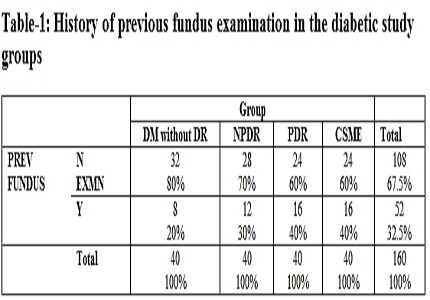Role of C- reactive protein in diabetic retinopathy
Abstract
Introduction: Diabetes mellitus is a major medical problem throughout the world. Diabetes causes an array of long-term systemic complications that have considerable impact on the patient as well as society, as the disease typically affects individuals in their most productive years. C Reactive Protein is an acute phase reactant and an inflammatory mediator involved in the pathogenesis of Diabetic Retinopathy.
Aim: The aim of this study is to determine the correlation of C-reactive protein with diabetic retinopathy and different grades of retinopathy.
Methods: The study was done on 200 diabetic patients attending the ophthalmology outpatient department, who were selected by purposive sampling. The patients were subjected to a complete ocular examination. Based on the fundus examination patients were categorized into the respective study groups: - 1) Controls 2) Diabetics without Diabetic Retinopathy 3) NPDR 4) PDR 5) CSME. The patients were then subjected to C- reactive protein estimation via laboratory analysis (Turbidometry Technique).
Results: The study showed that the mean CRP levels in diabetics were found to be 3mg/dl which is well within normal limits. The CRP levels were relatively higher in the PDR and CSME groups with it being elevated in 30% and 20% patients in the groups respectively.
Conclusion: CRP levels in our study did not show significant correlation with diabetes mellitus. Although higher grades of retinopathy had higher CRP levels, the correlation was not significant and consistent. Hence C- reactive protein cannot be used as a reliable screening tool for diabetic retinopathy.
Downloads
References
Rema M, Premkumar S, Anitha B, Deepa R, Pradeepa R, Mohan V. Prevalence of diabetic retinopathy in urban India: the Chennai Urban Rural Epidemiology Study (CURES) eye study, I. Invest Ophthalmol Vis Sci. 2005 Jul;46(7):2328-33.
Morimoto Y, Conroy SM, Ollberding NJ, Kim Y, Lim U, Cooney RV, Franke AA, Wilkens LR, Hernandez BY, Goodman MT, Henderson BE, Kolonel LN, Le Marchand L, Maskarinec G. Ethnic differences in serum adipokine and C-reactive protein levels: the multiethnic cohort. Int J Obes (Lond). 2014 Nov;38(11):1416-22. doi: https://doi.org/10.1038/ijo.2014.25. Epub 2014 Feb 13.
Kilpatrick ES, Keevil BG, Jagger C, Spooner RJ, Small M. Determinants of raised C-reactive protein concentration in type 1 diabetes. QJM. 2000 Apr;93(4):231-6.
Early Treatment Diabetic Retinopathy Study design and baseline patient characteristics. ETDRS report number 7. Ophthalmology. 1991 May;98(5 Suppl):741-56.
Schmidt AM, Hori O, Chen JX, Li JF, Crandall J, Zhang J, Cao R, Yan SD, Brett J, Stern D. Advanced glycation endproducts interacting with their endothelial receptor induce expression of vascular cell adhesion molecule-1 (VCAM-1) in cultured human endothelial cells and in mice. A potential mechanism for the accelerated vasculopathy of diabetes. J Clin Invest. 1995 Sep;96(3):1395-403.
Schram MT, Chaturvedi N, Schalkwijk C, Giorgino F, Ebeling P, Fuller JH, Stehouwer CD; EURODIAB Prospective Complications Study. Vascular risk factors and markers of endothelial function as determinants of inflammatory markers in type 1 diabetes: the EURODIAB Prospective Complications Study. Diabetes Care. 2003 Jul;26(7):2165-73.
Yuuki T, Kanda T, Kimura Y, Kotajima N, Tamura J, Kobayashi I, Kishi S. Inflammatory cytokines in vitreous fluid and serum of patients with diabetic vitreoretinopathy. J Diabetes Complications. 2001 Sep-Oct;15(5):257-9.
Funatsu H, Yamashita H, Ikeda T, Mimura T, Shimizu E, Hori S. Relation of diabetic macular edema to cytokines and posterior vitreous detachment. Am J Ophthalmol. 2003 Mar;135(3):321-7.
Boyer DS, Yoon YH, Belfort R Jr, Bandello F, Maturi RK, Augustin AJ, Li XY, Cui H, Hashad Y, Whitcup SM; Ozurdex MEAD Study Group. Three-year, randomized, sham-controlled trial of dexamethasone intravitreal implant in patients with diabetic macular edema. Ophthalmology. 2014 Oct;121(10):1904-14. doi: https://doi.org/10.1016/j.ophtha.2014.04.024. Epub 2014 Jun 4.
Schalkwijk CG, Poland DC, van Dijk W, Kok A, Emeis JJ, Dräger AM, Doni A, van Hinsbergh VW, Stehouwer CD. Plasma concentration of C-reactive protein is increased in type I diabetic patients without clinical macroangiopathy and correlates with markers of endothelial dysfunction: evidence for chronic inflammation. Diabetologia. 1999 Mar;42(3):351-7.



 OAI - Open Archives Initiative
OAI - Open Archives Initiative


